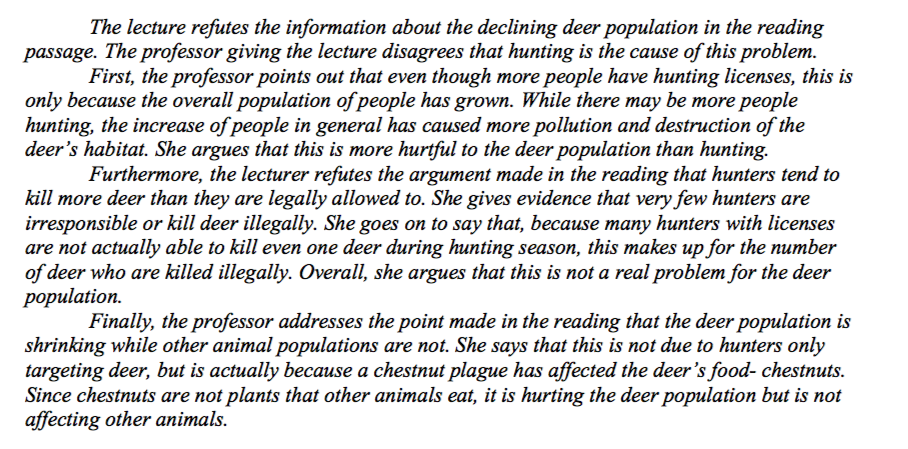By now you have a sense of the TOEFL writing section overall and are ready to dive in to Writing Question 1 in all its glory. (If not, go check out the overview of How to Teach TOEFL Writing here.) So without further ado, let’s get to the best, in-depth info on teaching the first TOEFL writing task:
Writing Question 1: details of the task and how to understand the prompt
For this task, students will first read a short passage on a particular topic. They will then listen to a short lecture on the same topic. The task requires them to summarize the points made in the lecture as compared to the points made in the passage. Here’s the breakdown:
The Passage
There is a wide variety of possibilities in terms of the topic of the passage. It may be about something related to science or animals or the environment; it could be about a famous author, painter, musician, or other artist; or it could be about a general topic such as people’s use of smart phones in daily life. The passage will state a specific opinion about this topic or present one side of an argument. Take a look at the example passage* below, noting the topic, the author’s position, and how it’s organized:
Local wildlife experts have noticed a decline in the population of white tailed deer (large, herbivorous mammals) in several regions of northern Michigan. While the population remains large enough that this is not yet cause for concern, experts have found this shift surprising and have decided to investigate the cause, as a continuation of this trend over several years may have detrimental effects on the local ecosystems. A preliminary investigation has led experts to believe that the decline of the white tailed deer population is mainly due to hunting practices.
The first reason for this theory is that the number of people in northern Michigan who have hunting licenses has gone up significantly in the last five years. This indicates that, in the regions where the deer population is declining, far more people are hunting deer than before. If deer are being hunted at a rate faster than they are able to reproduce, their numbers will start to decline.
Furthermore, there is evidence that some people who have hunting licenses tend to hunt and kill more than the legal of number of deer they are allowed to kill. Each license allows a hunter to kill only a set number of deer each year, but northern Michigan residents report that not all hunters obey this rule. Illegal killing of deer would certainly cause the population to decrease more quickly.
A third reason supporting this theory is that the population of other woodland animals in the affected regions has not gone down. Since deer hunters only kill deer and not squirrels, rabbits, raccoons, or other, smaller mammals, it makes sense that these populations would not be affected by the increase in hunting.
(**Disclaimer: This is a sample passage produced solely to give you a sense of the structure, information, and style of language test-takers encounter on this task of the TOEFL exam. While it is an accurate (as possible) representation of the exam task, it is not at all intended to give accurate information about wildlife or ecosystems of northern Michigan or anywhere else. Please don't hold me to any of these "facts" about deer, chestnuts, hunting, etc!)
As you can see, the passage is divided into four paragraphs. The first paragraph introduces the topic (the declining deer population in northern Michigan) and presents the author’s position: the population is declining because of hunting.
The next three paragraphs then give reasons for why the author has taken this position. Each reason should be clear from the first sentence of the paragraph. The rest of the paragraph gives more information or detail about each reason.
Prompt students to notice that every paragraph is still about the information given in the very first paragraph: the problem of the declining deer population due to hunting. Each paragraph just gives a different reason (or evidence) for this argument.
During the exam, test-takers have five minutes to read the passage and take notes. So get your students to practice by setting a timer and giving them the clear task of reading through the passage and noting the topic of the passage, the position the author takes, and the three reasons the author gives for this opinion. Have them take notes on a separate sheet of paper in a format like the one below:
Topic:
Opinion:
Reason 1:
Details:
Reason 2:
Details:
Reason 3:
Details:
*Remember that during the TOEFL exam, the actual passage will be read on a computer. So you’ll want to get students to practice by taking notes on an extra sheet of paper, not by underlining or circling parts of the passage. This will simulate what they’ll need to do in the real exam.
A few other important points to tell students about the passage:
Their only job is to identify/ record the information above
They do not need to consider whether they agree or disagree with the author’s stance
They do not need to think of any additional reasons
The Lecture
Once test-takers have read the passage, they will listen to part of a lecture on the same topic. A key thing to alert your students to is that the lecturer usually disagrees with the opinion given in the passage and argues the opposite side of the issue.
The lecturer will most likely begin with one or two statements about his/her opinion on the topic (or the opposite of whatever the passage said). Then the lecturer will give three reasons why the opposite side is actually true, and these reasons will directly contradict or refute the reasons given in the passage. They will even be in the same order, so the first reason that the lecturer gives will correspond to the first reason in the passage, and so on. For example, take a look at the transcript of the lecture** on the declining deer population below:
“Well, it turns out that the cause of decline in the deer population of northern Michigan is actually environmental factors like ecological issues and destruction of forests; it is not hunting like experts first thought.
First of all, while it is true that the number of people with hunting licenses is larger than it was five years ago, this number has increased only as a result of the increasing population of people in northern Michigan overall. The ratio of hunters to non-hunters has remained roughly the same. So it seems the problem is not that more people are hunting deer than before; it’s just that more people have moved into the regions white tailed deer normally inhabit. This has caused deforestation as more land is cleared for the building of residential and commercial areas, driving the deer out.
Additionally, though it may be true that some hunters kill more deer than they are legally allowed, we have to consider the fact that many hunters are not able to hit and kill a single deer each season. Research revealed that the number of unsuccessful hunters more than makes up for the number of hunters who make extra kills. And while it’s definitely possible that not all hunters obey the law, authorities have actually grown stricter in recent years about issuing and regulating hunting licenses. It appears that residents, speaking only on hearsay and not concrete data, were exaggerating the number of hunters who kill illegally.
And lastly, the question of why the deer population has decreased while other animal populations have remained unchanged can be traced to the chestnut tree. A recent tree plague affected many of the chestnut trees in northern Michigan, killing a large number of them. These chestnuts are an important source of food for white tailed deer, but most other woodland animals do not eat them as they are actually poisonous to certain species. Since the affected tree species is only a food source for deer, it makes sense that deer numbers would drop while the populations of other animals in the ecosystem would remain stable.”
(**Disclaimer round 2: Same deal as with the passage- this is only a sample intended to give you an idea of what a typical lecture transcript for this task looks like. I'm not saying English teachers can't be scientific researchers as well... but I'm definitely not one!)
Notice how each point in the lecture gives an alternative reason or piece of evidence that supports the overall opposite side of the issue. And again, each reason directly corresponds to one of the reasons in the passage.
To prepare students for this part of the task, play the recording of the lecture (check out the end of this post for a recommendation on how to get materials for your lessons!) and get them to take notes. Before you start the audio, tell students that the lecture will argue the opposite point as in the passage. This will help them predict what the lecturer is going to say. As they listen, students should practice noting down the lecturer’s opinion as well as the three reasons given for this. You can have them use a similar note-taking format:
Topic:
Opinion:
Reason 1:
Details:
Reason 2:
Details:
Reason 3:
Details:
Again, remind students that they do not need to consider which side they agree with, nor do they need to try to come up with any alternate reasons or explanations. Their only job is to note the position and reasons they hear.
Writing the Response
Now that students have a clear understanding of the passage and the lecture, teach them to craft their response. This will be a written summary in which students should focus on what the lecturer said and relate this to the information in the reading passage. Remind students that this is a summary only, not an essay about their opinions or a judgement about which position is correct.
Students SHOULD:
√ Mention all three reasons that the lecturer mentioned
√ Show how each reason relates to each reason in the reading passage
√ Use connecting language like First…, Furthermore..., Additionally…, Finally… etc.
√ Use correct grammar for reported speech and review common verbs used in reported speech (“The lecturer argues that…”, “she says…”, “she mentions…”)
√ Keep their response in the present tense (The lecturer argues, NOT The lecturer argued).
Students should NOT:
X Give their own opinion on the topic
X Say whether they agree more with the passage or the lecture
X Add in any information that was not in the lecture or passage
X Leave out any reasons that were given in the lecture and passage
X Write a conclusion- this isn’t needed and will just waste time and space
Advise students to begin by stating what the topic is and by stating the lecturer’s opinion. Have them relate this to the passage by writing that the lecturer disagrees with it. They should then write one short paragraph (3-4 sentences) for each reason the lecturer gives as to why he or she disagrees with the passage.
Here is an example of an appropriate response for the declining deer population topic:
This is a good response because it…
√ Is clearly organized into paragraphs
√ Begins by stating the topic and the fact that lecture contradicts the reading
√ Mentions each of the three reasons (one in each paragraph) that the lecturer gives
√ Does NOT give an opinion
√ Summarizes the points made in the lecture (it says what the lecturer said, but in different words)
√ Uses connecting language like first, furthermore, and finally and a variety of words for reported speech like the lecture refutes…, the professor points out…, she argues…, and she addresses the point that…
To summarize, the key things students need to practice in order to succeed in this task are:
Noting the position and three reasons given in the passage
Noting the alternative position and three directly contradictory reasons given in the lecture
Organizing their summary into four clear paragraphs (introduction + three reasons)
Using language to introduce and connect ideas
Using language for reported speech
Planning a TOEFL Writing Question 1 Lesson
Now that you’re an expert on the task, it’s time to plan your lesson. You’ll need material such as sample writing tasks (the written passages and recorded lectures from past exams) as well as sample responses. Consider buying a book of official TOEFL practice exams and going from there. The book contains five full practice exams; you can use each Writing Question 1 as material for crafting your writing lessons.
As you plan, keep in mind that students need to know:
1. How to pick out and take notes on key information from the passage and the lecture
2. How to brainstorm their response
3. The structure of a successful response (1-2 sentence introduction stating the lecturer’s position and then one paragraph for each reason given in the lecture)
4. Useful language for the task, such as synonyms for the word “says,” transition words like “first,” “second,” “finally,” etc, and grammar for reported speech
Your lesson should teach and provide practice on each of those things.



